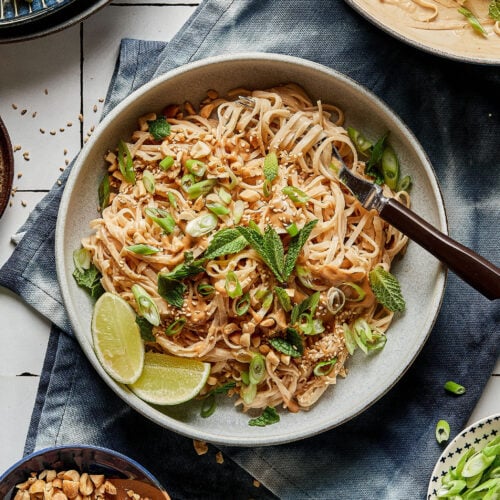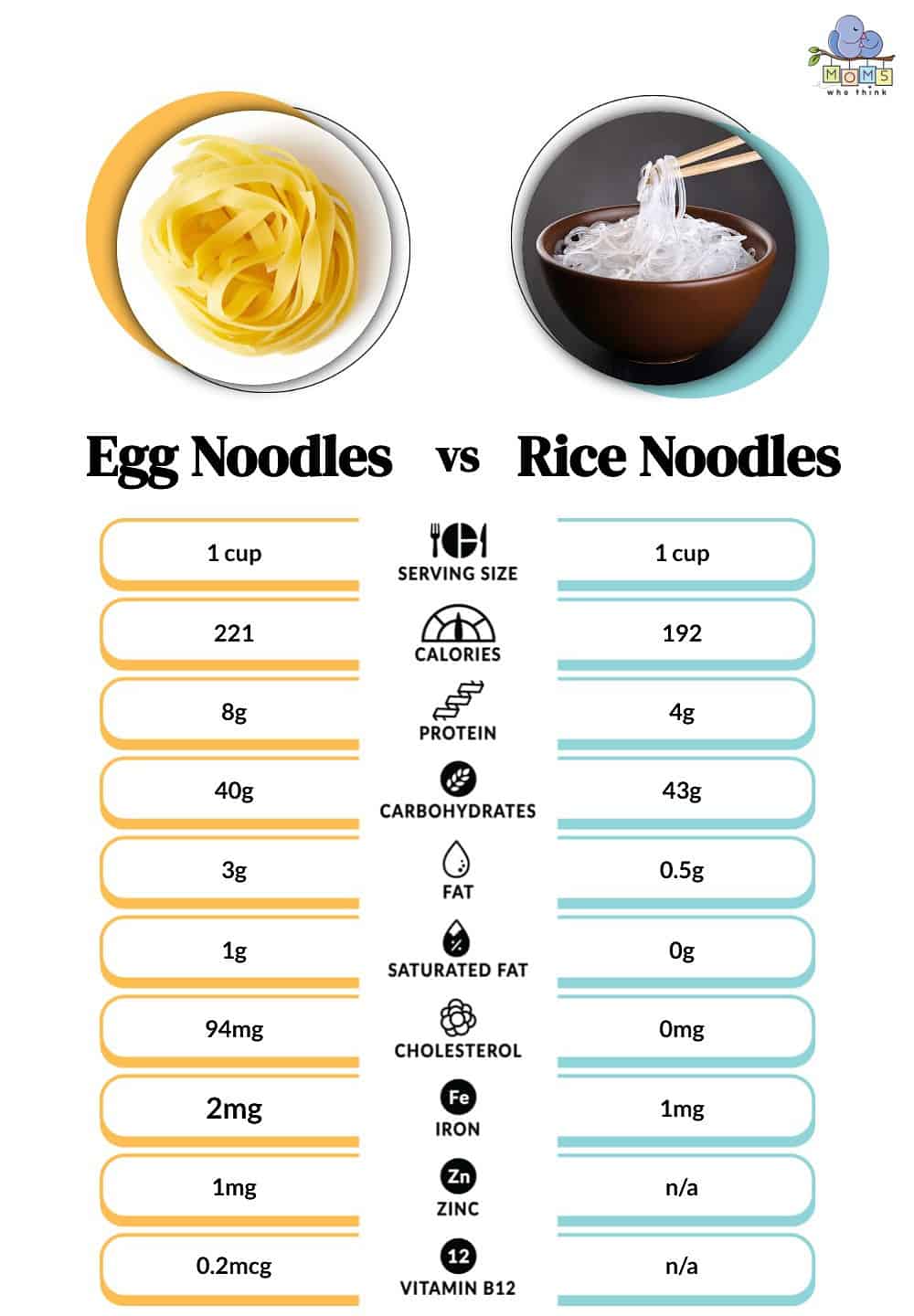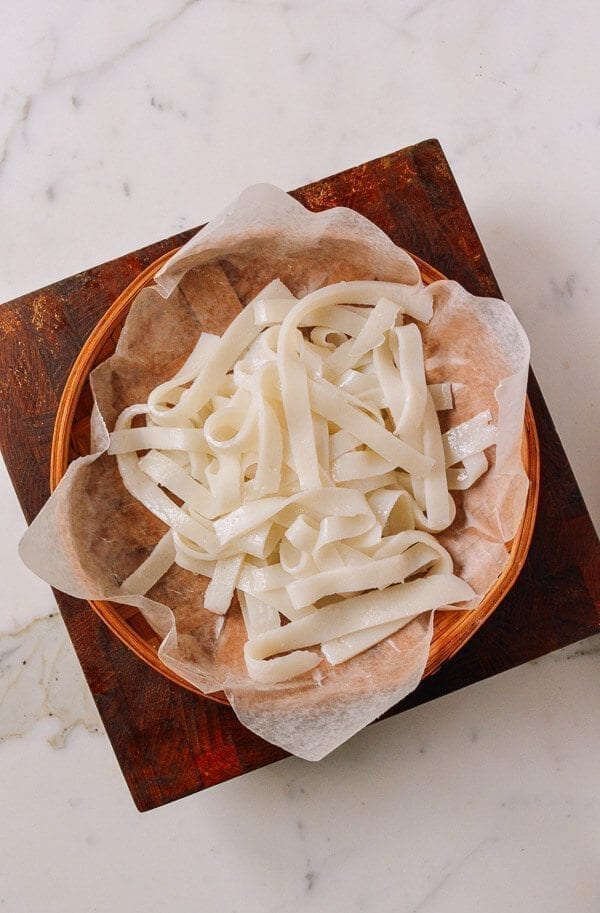
Introduction
Overview Of Rice Noodles And Their Popularity
Rice noodles have gained popularity in recent years, especially among individuals who follow gluten-free diets or have gluten allergies. These noodles are made from rice flour or rice starch and are a common ingredient in various Asian cuisines, including Thai, Vietnamese, and Chinese dishes. They are often used as a base for stir-fries, soups, and salads, and can be enjoyed both hot and cold.
Health Benefits Of Rice Noodles
Rice noodles offer several health benefits that make them a good choice for individuals with specific dietary needs or those looking to maintain a balanced diet. Some of the key benefits include:
- Gluten-free: One advantage of rice noodles is that they are gluten-free, making them suitable for individuals with gluten intolerance or celiac disease. Gluten is a protein found in wheat, barley, and rye, and can cause digestive issues for those who are intolerant.
- Low in fat: Rice noodles are low in fat, with approximately 0.2 grams per 100 grams of cooked noodles. This makes them a good option for individuals who are watching their fat intake or looking to maintain a healthy weight.
- Good source of carbohydrates: Rice noodles are a rich source of carbohydrates, providing energy for the body. A 100-gram serving of cooked rice noodles contains approximately 24 grams of carbohydrates.
- Vitamins and minerals: While rice noodles are not particularly high in vitamins and minerals, they do contain small amounts of essential nutrients such as phosphorus, sodium, calcium, potassium, iron, zinc, and selenium. These nutrients play a vital role in maintaining overall health and well-being.
While rice noodles can be a nutritious choice, it is essential to note that the nutritional content may vary depending on the cooking method and additional ingredients used. It is always advisable to check the nutrition label or consult a healthcare professional for personalized dietary advice.
Rice Noodles: Nutritional Profile
Calories In Rice Noodles
Rice noodles are relatively low in calories compared to other types of noodles. One cup (175g) of cooked rice noodles contains approximately 187 calories. This makes them a suitable option for individuals who are watching their calorie intake or trying to maintain a healthy weight.
Protein Content Of Rice Noodles
While rice noodles are not a significant source of protein, they still provide a small amount. One cup of cooked rice noodles contains approximately 3.1 grams of protein. Protein is essential for building and repairing tissues, and it also plays a role in various bodily functions.
In addition to their calorie and protein content, rice noodles offer other nutritional benefits. They are low in fat, with only 0.4 grams per cup. This makes them a good choice for individuals who are looking to reduce their fat intake.
Rice noodles are also a good source of carbohydrates. One cup of cooked rice noodles contains approximately 41.8 grams of carbohydrates, which provides the body with energy.
Although rice noodles are not particularly high in vitamins and minerals, they do contain small amounts of essential nutrients such as phosphorus, sodium, calcium, potassium, iron, zinc, and selenium. While these amounts may be small, they still contribute to overall health and well-being.
It is important to note that the nutritional profile of rice noodles may vary depending on the cooking method and additional ingredients used. It is always advisable to check the nutrition label or consult a healthcare professional for personalized dietary advice.
Rice Noodles: Carbohydrates And Fiber
Carbohydrate Content Of Rice Noodles
Rice noodles are a carbohydrate-rich food. One cup of cooked rice noodles contains approximately 41.8 grams of carbohydrates. This makes them a good source of energy for the body. However, individuals who follow a low-carb diet or monitor their carbohydrate intake should be mindful of their portion sizes when consuming rice noodle dishes.
Dietary Fiber In Rice Noodles
While rice noodles do contain a small amount of dietary fiber, with 1.75 grams per serving, they are not a significant source of fiber compared to unprocessed brown rice or regular pasta. Fiber is an important nutrient that aids in digestion and helps regulate blood sugar levels. Individuals looking to increase their fiber intake should consider incorporating other fiber-rich foods into their diet, such as fruits, vegetables, whole grains, and legumes.
It is important to note that the nutritional profile of rice noodles may vary depending on the cooking method and additional ingredients used. It is always advisable to check the nutrition label or consult a healthcare professional for personalized dietary advice.
In addition to their carbohydrate and fiber content, rice noodles are low in fat, with less than 1 gram of fat per serving. They also provide a small amount of protein, with approximately 3.1 grams per cup. While rice noodles may not be particularly high in vitamins and minerals, they do contain small amounts of essential nutrients such as phosphorus, sodium, calcium, potassium, iron, zinc, and selenium.
Rice noodles are a popular choice in Asian-style cooking and can be enjoyed in a variety of dishes. Whether you are watching your calorie intake or looking for a carbohydrate-rich option, rice noodles can be a versatile addition to your meals. Remember to enjoy them in moderation and incorporate a variety of nutrient-rich foods into your diet for optimal health and well-being.

Rice Noodles: Fat And Sodium
Fat Content Of Rice Noodles
Rice noodles are a low-fat option, with less than 1 gram of fat per serving. This makes them a suitable choice for individuals looking to reduce their fat intake or maintain a healthy weight. Compared to regular noodles made from wheat, which can be higher in fat, rice noodles offer a lighter alternative.
Sodium Levels In Rice Noodles
One important consideration when consuming rice noodles is the sodium content. One cup of cooked rice noodles contains approximately 438 milligrams of sodium. While this is not particularly high, individuals following a low-sodium diet or those with high blood pressure should keep this in mind and adjust their portion sizes accordingly. It is always advisable to check the nutrition label or consult a healthcare professional for personalized dietary advice.
Rice noodles, made from rice flour, are a popular choice in Asian-style cooking. They are a versatile option that can be enjoyed in various dishes. With their low-fat content and moderate levels of sodium, rice noodles can be incorporated into a balanced diet. However, it is important to note that the overall nutritional profile of rice noodles may vary depending on the cooking method and additional ingredients used.
When incorporating rice noodles into your meals, be mindful of portion sizes and consider adding other nutrient-rich foods to ensure a well-rounded diet. Vegetables, lean proteins, and whole grains can be combined with rice noodles to provide a balanced and nutritious meal. Whether you are looking for a low-fat option or a carbohydrate-rich choice, rice noodles can be a tasty addition to your culinary repertoire.
Rice Noodles: Micronutrients
Rice noodles, while not a significant source of micronutrients, do provide some essential nutrients. Here are two key micronutrients found in rice noodles:
Selenium Content In Rice Noodles
Rice noodles contain a small amount of selenium, a trace mineral that plays a crucial role in maintaining proper thyroid function and supporting a healthy immune system. One cup of cooked rice noodles provides approximately 10 micrograms of selenium. While this may not fulfill your entire daily requirement for selenium, it can contribute to your overall intake when consumed as part of a balanced diet.
Thiamine (vitamin B1) In Rice Noodles
Rice noodles also contain thiamine, also known as Vitamin B1, although in small amounts. Thiamine is essential for the proper functioning of the nervous system and helps convert food into energy. Each serving of cooked rice noodles provides approximately 0.03 milligrams of thiamine, which meets around 3% of the daily value. While this may not be a significant source of thiamine, it can contribute to your overall intake when combined with other thiamine-rich foods.
It is important to note that the micronutrient content in rice noodles may vary depending on the brand and cooking method. Additionally, the overall nutritional profile of your meals should not rely solely on rice noodles, but include a variety of nutrient-rich foods to ensure a well-rounded diet.
Incorporating rice noodles into your meals can add variety and flavor to your diet. However, it is always advisable to consider portion sizes and balance them with other nutrient-dense ingredients to create a balanced and nutritious meal. Vegetables, lean proteins, and whole grains can be combined with rice noodles to enhance the overall nutritional value of your dish.
As with any dietary choice, it is recommended to consult with a healthcare professional or registered dietitian for personalized advice, especially if you have specific dietary restrictions or health conditions.
Health Conditions And Rice Noodles
Impact Of Rice Noodles On Diabetes
Rice noodles can be a suitable option for individuals with diabetes due to their moderate protein and carbohydrate content. Unlike refined wheat-based noodles, rice noodles have a lower glycemic index, which means they cause a slower and more gradual increase in blood sugar levels. This can help with blood sugar control and prevent spikes in insulin production. However, portion control is important to consider, as consuming excessive amounts of rice noodles can still lead to elevated blood sugar levels. It is recommended to pair rice noodles with vegetables and lean protein to create a balanced meal that further promotes stable blood sugar levels.
Rice Noodles And Gluten Sensitivity
For individuals with gluten sensitivity or celiac disease, rice noodles are a great gluten-free alternative to wheat-based noodles. Rice noodles are naturally gluten-free as they are made from rice flour, which does not contain gluten protein. This makes them a suitable choice for those who need to avoid gluten in their diet. However, cross-contamination can occur during the manufacturing process, so it’s important to look for certified gluten-free rice noodle brands if you have severe gluten sensitivity or celiac disease.
It’s also worth noting that rice noodles should not be used as a complete replacement for other nutrient-dense foods. While they provide some essential nutrients and can be a part of a healthy diet, it’s important to incorporate a variety of foods from different food groups to ensure a well-rounded and balanced nutritional intake.
As with any dietary consideration, it is always recommended to consult with a healthcare professional or registered dietitian for personalized advice, especially if you have specific dietary restrictions or health conditions. They can provide guidance on portion sizes, meal planning, and help you create a diet that meets your individual needs and goals.

How To Cook Rice Noodles
Step-by-step Guide To Cooking Rice Noodles
To cook rice noodles perfectly, follow these steps:
- Bring a large pot of water to boil. The amount of water should be at least four times the volume of the rice noodles.
- Add a pinch of salt to the boiling water. This helps to season the noodles as they cook.
- Place the rice noodles in the boiling water. Stir gently to separate the noodles and prevent them from sticking together.
- Cook the rice noodles for the recommended cooking time mentioned on the package. This can vary depending on the thickness and type of noodles, so it’s best to follow the package instructions.
- Once the noodles are cooked, drain them in a colander and rinse them under cold water. This stops the cooking process and helps to remove excess starch, preventing the noodles from becoming clumpy.
- Toss the noodles with a little oil or sesame oil to prevent them from sticking together until you are ready to use them in your dish.
Tips For Achieving The Perfect Texture
- Soak the dried rice noodles in warm water for about 30 minutes before cooking. This helps to soften them and ensures a more even and tender texture.
- Avoid overcooking the rice noodles, as they can quickly become mushy and lose their chewiness. Cook them just until they are al dente, meaning they still have a slight bite to them.
- If you are stir-frying the rice noodles, make sure your wok or skillet is hot before adding them. This helps to prevent sticking and ensures they cook quickly and evenly.
- If you prefer a softer texture, you can cook the rice noodles for a slightly longer time, but be cautious not to overcook them.
With this guide, you can confidently cook rice noodles to achieve the perfect texture and enjoy them in your favorite Asian dishes.
How To Cook Rice Noodles
Step-by-step Guide To Cooking Rice Noodles
To cook rice noodles perfectly, follow these steps:
- Bring a large pot of water to boil. The amount of water should be at least four times the volume of the rice noodles.
- Add a pinch of salt to the boiling water. This helps to season the noodles as they cook.
- Place the rice noodles in the boiling water. Stir gently to separate the noodles and prevent them from sticking together.
- Cook the rice noodles for the recommended cooking time mentioned on the package. This can vary depending on the thickness and type of noodles, so it’s best to follow the package instructions.
- Once the noodles are cooked, drain them in a colander and rinse them under cold water. This stops the cooking process and helps to remove excess starch, preventing the noodles from becoming clumpy.
- Toss the noodles with a little oil or sesame oil to prevent them from sticking together until you are ready to use them in your dish.
Tips For Achieving The Perfect Texture
Here are some tips for cooking rice noodles to achieve the perfect texture:
- Soak the dried rice noodles in warm water for about 30 minutes before cooking. This helps to soften them and ensures a more even and tender texture.
- Avoid overcooking the rice noodles, as they can quickly become mushy and lose their chewiness. Cook them just until they are al dente, meaning they still have a slight bite to them.
- If you are stir-frying the rice noodles, make sure your wok or skillet is hot before adding them. This helps to prevent sticking and ensures they cook quickly and evenly.
- If you prefer a softer texture, you can cook the rice noodles for a slightly longer time, but be cautious not to overcook them.
With this guide, you can confidently cook rice noodles to achieve the perfect texture and enjoy them in your favorite Asian dishes.
Rice Noodle Recipes
Popular Rice Noodle Dishes
Rice noodles are a versatile ingredient that can be used in various dishes from different cuisines. Here are some popular rice noodle dishes you can try:
- Phở: a traditional Vietnamese soup dish made with rice noodles, beef or chicken broth, and various toppings such as sliced beef, bean sprouts, herbs, and lime.
- Sawine: a dish commonly found in South Asian and Caribbean cuisines, made with vermicelli rice noodles cooked in a sweetened milk sauce with nuts, raisins, and spices.
- Pad Thai: a famous Thai stir-fried noodle dish that typically includes rice noodles, shrimp or chicken, eggs, bean sprouts, peanuts, and a tangy sauce made from tamarind paste, fish sauce, and palm sugar.
Healthy And Delicious Rice Noodle Recipes
If you’re looking for healthy and delicious rice noodle recipes, here are a few ideas to try:
- Vietnamese Rice Paper Rolls: These fresh and vibrant rice paper rolls are filled with rice noodles, vegetables, and herbs, and served with a peanut dipping sauce.
- Spicy Peanut Noodle Salad: A refreshing salad made with rice noodles, crisp vegetables, and a spicy peanut dressing.
- Stir-Fried Rice Noodles with Vegetables: A simple and nutritious stir-fry dish that combines rice noodles with a variety of colorful vegetables and a flavorful sauce.
These recipes are just a starting point, and you can always experiment with different ingredients and flavors to create your own delicious rice noodle dishes. Enjoy exploring the world of rice noodles!
How To Cook Rice Noodles
Step-by-step Guide To Cooking Rice Noodles
To cook rice noodles perfectly, follow these steps:
- Bring a large pot of water to boil. The amount of water should be at least four times the volume of the rice noodles.
- Add a pinch of salt to the boiling water. This helps to season the noodles as they cook.
- Place the rice noodles in the boiling water. Stir gently to separate the noodles and prevent them from sticking together.
- Cook the rice noodles for the recommended cooking time mentioned on the package. This can vary depending on the thickness and type of noodles, so it’s best to follow the package instructions.
- Once the noodles are cooked, drain them in a colander and rinse them under cold water. This stops the cooking process and helps to remove excess starch, preventing the noodles from becoming clumpy.
- Toss the noodles with a little oil or sesame oil to prevent them from sticking together until you are ready to use them in your dish.
Tips For Achieving The Perfect Texture
Here are some tips for cooking rice noodles to achieve the perfect texture:
- Soak the dried rice noodles in warm water for about 30 minutes before cooking. This helps to soften them and ensures a more even and tender texture.
- Avoid overcooking the rice noodles, as they can quickly become mushy and lose their chewiness. Cook them just until they are al dente, meaning they still have a slight bite to them.
- If you are stir-frying the rice noodles, make sure your wok or skillet is hot before adding them. This helps to prevent sticking and ensures they cook quickly and evenly.
- If you prefer a softer texture, you can cook the rice noodles for a slightly longer time, but be cautious not to overcook them.
With this guide, you can confidently cook rice noodles to achieve the perfect texture and enjoy them in your favorite Asian dishes.
Rice Noodle Recipes
Popular Rice Noodle Dishes
Rice noodles are a versatile ingredient that can be used in various dishes from different cuisines. Here are some popular rice noodle dishes you can try:
- Phở: a traditional Vietnamese soup dish made with rice noodles, beef or chicken broth, and various toppings such as sliced beef, bean sprouts, herbs, and lime.
- Sawine: a dish commonly found in South Asian and Caribbean cuisines, made with vermicelli rice noodles cooked in a sweetened milk sauce with nuts, raisins, and spices.
- Pad Thai: a famous Thai stir-fried noodle dish that typically includes rice noodles, shrimp or chicken, eggs, bean sprouts, peanuts, and a tangy sauce made from tamarind paste, fish sauce, and palm sugar.
Healthy And Delicious Rice Noodle Recipes
If you’re looking for healthy and delicious rice noodle recipes, here are a few ideas to try:
- Vietnamese Rice Paper Rolls: These fresh and vibrant rice paper rolls are filled with rice noodles, vegetables, and herbs, and served with a peanut dipping sauce.
- Spicy Peanut Noodle Salad: A refreshing salad made with rice noodles, crisp vegetables, and a spicy peanut dressing.
- Stir-Fried Rice Noodles with Vegetables: A simple and nutritious stir-fry dish that combines rice noodles with a variety of colorful vegetables and a flavorful sauce.
These recipes are just a starting point, and you can always experiment with different ingredients and flavors to create your own delicious rice noodle dishes. Enjoy exploring the world of rice noodles!
Conclusion
Summary Of The Nutritional Value Of Rice Noodles
Rice noodles are moderate in protein and carbs, while being low in fat and fiber. They are a good source of selenium, providing 14% of the Daily Value (DV) in each serving.
Considerations When Incorporating Rice Noodles Into Your Diet
Rice noodles can be a healthy addition to your diet, but it’s important to consider portion sizes and the other ingredients in your dish. Some rice noodle dishes may be high in sodium, added sugars, or unhealthy fats, so it’s best to choose recipes that incorporate lean proteins, plenty of vegetables, and flavorful spices for a balanced meal.
FAQ about Rice Noodles Nutrition Facts: What You Need to Know
Q: What are rice noodles?
A: Rice noodles are a type of noodle made from rice flour and water. They are commonly used in a variety of Asian cuisines and are a popular gluten-free alternative to wheat-based noodles.
Q: Are rice noodles healthy?
A: Rice noodles can be a healthy choice, especially for those with gluten sensitivities. They are low in fat and cholesterol and contain no saturated or trans fats. However, it’s essential to consider portion sizes and cooking methods to maintain their nutritional benefits.
Q: Are rice noodles high in calories?
A: Rice noodles are relatively low in calories compared to other types of noodles. One cup of cooked rice noodles contains about 192 calories. However, keep in mind that calorie content may vary depending on the brand and cooking method.
Q: Are rice noodles a good source of fiber?
A: While rice noodles are not a significant source of fiber, they do contain small amounts. One cup of cooked rice noodles provides about 1-2 grams of fiber. To increase your fiber intake, consider pairing rice noodles with vegetables or adding fibrous toppings.
Q: Are rice noodles gluten-free?
A: Yes, rice noodles are gluten-free since they are made from rice flour. They are a suitable option for individuals with gluten sensitivities or those following a gluten-free diet.
Q: Are rice noodles high in carbohydrates?
A: Rice noodles are primarily made of rice flour, which contributes to their higher carbohydrate content. One cup of cooked rice noodles contains approximately 44-46 grams of carbohydrates. It is important to consider portion sizes if you are watching your carbohydrate intake.
Q: Do rice noodles contain any protein?
A: Rice noodles are not a significant source of protein. One cup of cooked rice noodles contains about 3-5 grams of protein. If you’re looking to increase your protein intake, consider adding protein-rich ingredients like tofu, chicken, or shrimp to your dish.
Q: How do the nutritional values of rice noodles compare to other types of noodles?
A: Rice noodles tend to have lower fat content compared to egg noodles or wheat-based noodles. They are also gluten-free, which sets them apart from wheat-based noodles. However, the nutritional profile can vary between brands and preparation methods, so it’s always good to check the label.
Q: Can rice noodles be part of a balanced diet?
A: Yes, rice noodles can be part of a balanced diet when consumed in moderation and paired with nutritious ingredients. Consider incorporating vegetables, lean proteins, and healthy fats to make a well-rounded meal.
Q: How should rice noodles be cooked to retain their nutritional value?
A: To retain the nutritional value of rice noodles, it’s best to cook them using methods like steaming, boiling, or stir-frying with minimal oil. Avoid deep-frying, as it can significantly increase the fat content.
Please note that the nutritional information provided may vary depending on the brand, cooking method, and other ingredients added to the dish. It’s always a good idea to consult the nutrition label and consider portion sizes to make informed choices about your meals.

We are a small takeaway restaurant offering a great selection of food cooked by our Thai chef. Table spaces are limited, so please book in advance.